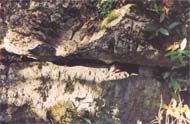|
|
|
|
Fig. 1 |
|
Fig. 5 |
|
SEZIONE POSTER PREISTORIA E MUSEI
IN EUROPA 28-29 APRILE 1999,
ISERNIA An archaeoastronomic
open museum on the Caprione's Promontory.
Some papers
(Martini S., 1996; Martini S. & Barsanti C. M., 1997 and Negrino
F., 1998) affirm that in Ligurian rocky territory there is no
megalithism and, consequently, no archaeoastronomy. We think that
on the Ligurian promontory of Caprione (oscan = kaprum) there
is existence of:
The ara (FIG. 1) positioned
in the Branzi's site (celtic = bram) is made up by: The ara (FIG. 2) located
in the Scornia's site (celtic = skeir-na) is made up by:
The systematic occurrence of different lithotypes overlapped, in some areas without any landslides, faults or stratigraphic boundaries that could contact different rocks, would suggest an anthropic action; according to the authors, a geological approach (Fig. 4) can help to understand the Eastern Ligurian megalithism, in absence of archaeological finds (actually not yet started any excavations).
Fig. 4 - Geological stratigraphy The sciamanism's
existence is demonstrated by the experience of the "golden butterfly"
(regeneration myth, relative to Neolithic cults - Gimbutas M.,
1990) that appears at the summer's solstice sunset on a phallic
stone opposed to the San Lorenzo's Quadrilithon and next to a
vulviform figure.
|
 |
|
Fig. 2
|
 |
|
Fig. 3
|
|
Fig. 6 |

